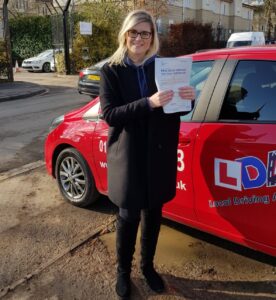Stopping Distances and the Theory Test, UK
Are you preparing for your UK Driving Theory Test but keep getting caught out by the questions on stopping distances, braking distances and thinking distances? If so, check out the information below which should help you to explain the differences and help you remember the correct stopping distances so you’re not left confused and panicking on the day of your Theory Test!
Get in touch today for intensive driving lesson courses, manual or automatic driving lessons with an established, trustworthy, DSA approved driving academy. Call now on 01865 722 148 or send a message via the Contact Form online and schedule in your driving lessons.
So what are the differences between the Thinking Distance, Braking Distance and Stopping Distance?
Thinking Distance
The Thinking Distance is the time it takes for you to activate your brakes, and the distance you have travelled before they start to affect the speed of the car.
TIP: Thinking Distance is appropriately 1 foot for every mph you are travelling at. So for example, if you are travelling at 30mph then your thinking distance is approximately 30 feet.
Braking Distance
Braking Distance is the distance your car travels after you have applied the brakes until your vehicle comes to a stop. The faster you are travelling, the more momentum you have and the braking distance will, therefore, increase accordingly.
Stopping Distance
Stopping Distance is the total distance you travel before you hit the brakes plus the distance you travel while the brakes slow you down. Thinking + Braking Distance = Overall Stopping Distance.

How to remember Stopping Distances by Speed
TIP: Here is a great way to remember the overall stopping distances. Starting from 20mph you simply multiply the speed by intervals of 0.5, beginning with 2, for example, 2, 2.5, 3, 3.5 etc as follows:
| 20mph x 2 = 40 feet ((12 meters) or 3 car lengths) |
| 30 mph x 2.5 = 75 feet ((23 meters) or 6 car lengths) |
| 40 mph x 3 = 120 feet ((36.5 meters) or 9 car lengths) |
| 50 mph x 3.5 = 175 feet ((53 meters) or 13 car lengths) |
| 60 mph x 4 = 240 feet ((73 meters) or 18 car lengths) |
| 70 mph x 4.5 = 315 feet ((96 meters) or 24 car lengths) |
The above calculations are a simple way to help you remember the correct stopping distances, but please be aware that these are approximate. The overall stopping distance is really the only safe separation gap, anything less than this can be considered a risk.
Stopping distance at 20mph = 40 feet (12 meters)
Stopping distance at 30mph = 75 feet ( 23 meters)
Stopping distance at 40mph = 24- feet (73 meters)
Stopping distance at 50mph = 175 feet (53 meters)
Stopping distance at 60mph = 240 feet (73 meters)
Stopping distance at 70mph = 315 feet (96 meters)
The Highway Code – Stopping Distances
The distances shown below are a general guide. The distance will depend on your attention (thinking distance), the road surface, the weather conditions and the condition of your vehicle at the time.
What affects overall car stopping distances? – ( What will affect your vehicle’s stopping distance? )

You must always remember that the overall stopping distance of your vehicle depend greatly on a considerable number of factors including:
- How fast you are travelling
- Whether you are on a level road, or a hill going up or down, and the steepness of that hill.
- Weather, is it good and dry, or is it wet or icy (stopping distance may increase upto 10 times in icy conditions)
- Tyres, are they good tyres and properly inflated, or worn or badly inflated
- Brakes, are they working well, are they stopping you in a straight line.
- Your ability as a driver, are you ill, tired, on medication, have drunk alcohol, are distracted, all of these can affect your reactions when applying brakes.
So these factors will affect your vehicle’s overall stopping distance.
Separation Distances
Separation distances are safety margins or empty road between you and the vehicle in front. Separation distances are essential to allow you time to see and react appropriately to any potential or developing hazard.
How much can stopping distance increase in icy conditions?
Stopping distance of your vehicle may increase upto 10 times in icy conditions. Reducing speed and allowing more distance between the vehicles is important in icy conditions.
Tips to ensure you don’t get caught out in the Theory Test UK
Make sure you read every question thoroughly. One very common occurrence is that test candidates do not read the question properly and as a result mark the incorrect answer when being asked about stopping or braking distances. Always make sure that you read every driving Theory Test question at least twice on the day of your test, but most importantly TAKE YOUR TIME! You’ll not score additional points for finishing your test early, so make good use of the allocated time you have to read every question and possible answer thoroughly.
And finally…
Check out the Learning To Drive Apps we recommend.
